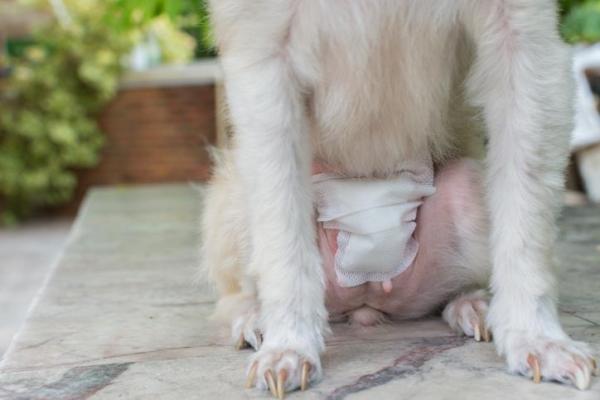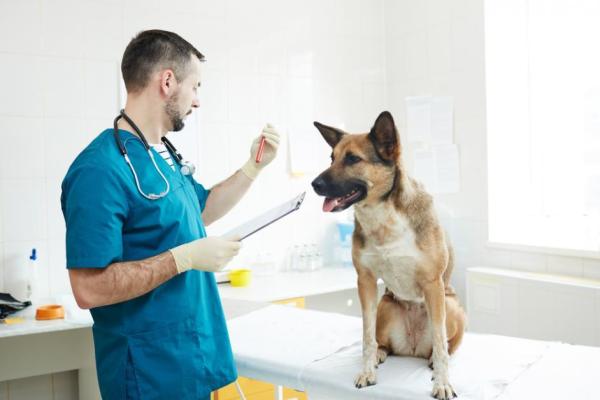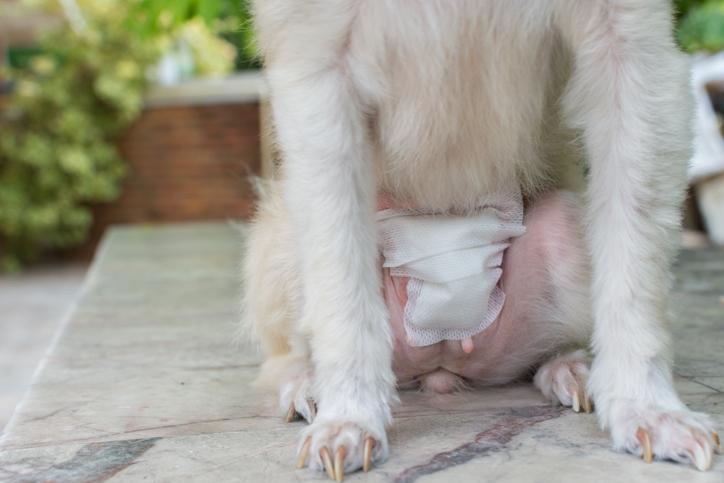My Spayed Female Dog Is Bleeding From Her Private Area



See files for Dogs
We do not expect a female dog to bleed from her private area if she has been spayed. Also known as an ovariohysterectomy, spaying is a process whereby the reproductive organs of the dog are removed. This means the dog cannot go into their heat cycle, something which can be accompanied by a certain amount of blood spotting. If we see our dog has blood on her privates and they have been spayed, we need to consider the time since the procedure has been carried out. Bleeding soon after spaying surgery will likely be a complication of the surgery. If the bleeding occurs long after they have healed, it is likely due to a problem unrelated to the surgery itself
Although bleeding after dog sterilization is relatively rare, a dog that has recently been spayed/castrated can experience bloody discharge or bruising. For this reason, at AnimalWised we will be discussing why my spayed female dog is bleeding form her private area.
- What is spaying in dogs?
- Complications after spaying surgery
- Is it normal for a female dog to bleed after spaying?
- Do spayed dogs get periods?
- Brown discharge from a spayed female dog
- Should I be worried if my spayed female dog is bleeding from her private area?
- Dog bleeding after spay treatment
- Ovarian remnant syndrome
What is spaying in dogs?
Before explaining whether it is normal for a spayed feamel dog to bleed from her private area, we recommend understanding what exactly dog spaying means. In order to do this, we need to understand the difference between neutering of male dog and female dogs[1].
Although there are several techniques for sterilizing a dog, we will refer to the two most common types:
- Male dog neutering: castration of a male dog is a simpler intervention than that of a female. This is because a male dog’s genitals are found outside the body. A veterinarian will make an incision in the scrotum, through which they extract the testicles. This incision is usually closed again with a couple of visible or non-visible stitches, which are later removed.
- Female dog neutering: spaying a female dog is done through an incision in the abdomen. A veterinarian will extract the ovaries and uterus, normally arranged in the form of a Y shape. The different layers are sutured both internally externally. The incision can also be closed with staples. This surgery is known as an ovariohysterectomy and is carried out if we don't want the dog to have puppies.
In the cases of both castration and spaying the wound needs to be protected. After-care of spaying and castration both require keeping the wound covered, making sure that the dog does not lick, scratch or bite the wound. To avoid this, your veterinarian can give provide your dog with an E-collar. For more, take a look at our article on how to stop a dog scratching a wound.
In addition, it is important to keep your dog’s wound clean while it heals. A professional will be able to administer the appropriate cleaning medication and disinfectant.
Complications after spaying surgery
Complications after surgical neutering are uncommon. While bleeding from the private area in a spayed female dog is a cause for concern, there are various complications which can arise in these rare circumstances. This is why it is important to monitor the animal closely after the procedure. However, there are certain behaviors and symptoms which might be relatively normal after sterilization.
- Dog crying after anesthesia: when the dog eventually comes round from the anesthesia, it is common for some to cry or whimper a little. They are likely disorientated by the anesthesia and the stitches will cause further discomfort. Another issue is that they may be hungry, although we shouldn't feed them too much too soon.
- Dog heavy panting after surgery: another sign of discomfort is that the dog is panting heavily after being spayed or neutered. This is also due to the often traumatic experience of the surgery and why veterinarians will usually prescribe pain medication to manage these symptoms.
- Dog disorientated after surgery: since the dog has been given certain drugs, when they regain consciousness it is understandable they will be a little confused.
- Dog drooling after anesthesia: drooling after being given anesthetic is a natural reaction to loss of muscles control.
The above aide effects of sterilization surgery are considered normal up to several hours after the surgery. However, if they continue into the next day, you should call the veterinary clinic to discuss the symptoms as they may be a sign of complications.

Is it normal for a female dog to bleed after spaying?
When removing a dog’s uterus and ovaries, an incision is always made. It is normal that at times this incision will result in light bleeding during the intervention or after surgery. This bleeding is normally controlled by the veterinarian performing the surgery.
During surgery, the dog may be given certain anesthetic drugs such as propofol[3]. This drug lowers the dog's blood pressure, which will raise again once they gain consciousness. The increased blood pressure can cause some seepage from the wound, but it should not be excessive.
During a dog’s postoperative period, due to the incision and invasive techniques used, it is normal that the surrounding area will be have a red or purple hue. This is otherwise known as a hematoma, i.e. blood that remains under the skin which causes a bruise-like effect. If the bruising is seen all over the abdomen, this is not considered normal and may signal internal bleeding.
At times, this wound can also appear inflamed. In this case, female dog bleeding a little after spaying is normal. This is often largely due to a fallen stitch, that hasn’t yet closed the wound. In this case, the bleeding will be minimal, remitting in seconds.
Do spayed dogs get periods?
Spayed dogs do not experience heat cycles or menstruation. We have already explained that spaying involves the removal of the uterus and often the ovaries eliminating the reproductive organs responsible for the heat cycle and the associated hormonal changes in female dogs. After spaying, the dog no longer goes into heat. This means there is no shedding of the uterine lining, which is what occurs during menstruation in some mammals.
Even sexually intact dogs will not get periods. Dogs do not experience menstruation in the same way that humans do. Instead of a menstrual cycle, female dogs go through a reproductive cycle known as the estrous cycle which is the proper term for the heat cycle. During the heat cycle, hormonal changes occur and the dog becomes receptive to mating.
The estrous cycle typically occurs twice a year, although the frequency can vary among individual dogs and breeds. During this time, a female dog may exhibit certain behavioral changes, such as increased friendliness, restlessness and a swollen vulva. There may also be a bloody discharge, which is a normal part of the cycle.
Brown discharge from a spayed female dog
Brown discharge from a spayed female dog can have various causes. It's important to note that any abnormal discharge from a spayed dog should be evaluated by a veterinarian. Some possible reasons for brown discharge in a spayed female dog include:
- Residual blood: in the immediate postoperative period, some dogs may have residual blood discharge which can appear brown.
- Infection: whether at the incision site or in the reproductive tract, infections can lead to discolored discharge.
- Vaginitis: inflammation of the vagina (vaginitis) can cause changes in vaginal discharge color.
- Urinary tract infection (UTI): infections in the urinary tract can sometimes cause changes in vaginal discharge. Learn more about the types of urinary tract infections in dogs with our related guide.
- Foreign body or suture reaction: occasionally, reactions to sutures or the presence of a foreign body can lead to discharge.
- Hormonal changes: even in spayed dogs, hormonal imbalances might cause changes in discharge.
Since brown discharge can be a sign of various underlying issues, a veterinary examination is necessary to determine the underlying cause.
Should I be worried if my spayed female dog is bleeding from her private area?
While minimal bleeding after a dog’s surgery is normal, excessive bleeding is a cause for concern. If your dog is bleeding after being spayed, the amount of blood present needs to be assessed along with other symptoms. Immediate intervention is required in the following two circumstances:
- When bleeding comes from a specific external point, such as stitches or staples, it might be because they have been detached. In this case, treatment will involve the veterinarian re-suturing the entire incision. If there is excessive bleeding with an evident open wound, it needs to be attended to by a professional immediately. If not, organ prolapse from the incision is possible. An open wound also heightens the risk of infection.
- Bleeding can also be internal. If your female dog is bleeding a lot after being spayed, other symptoms may be noticed. These signs include pale mucous membranes, apathy or a drop in body temperature. Such symptoms also require immediate veterinary attention, as they can result in shock.
If the bruises caused by sterilization are not extensive, go away and are not painful for your animal, veterinary consultation is not required. However, if your dog feels pain and is experiencing excessive bleeding after being spayed, we recommend visiting your veterinarian as soon as possible. When the abdomen is bruised and inflamed all over, this is particularly worrying.
If your dog is bleeding abnormally after neutering or spaying, be sure to consult a specialist.
Dog bleeding after spay treatment
If you see an excessive amount of bloody discharge after a female dog is spayed, then we need to see a veterinarian. They will be able to asses the dog's health and perform an examination of the incision site. Only then will you be able to treat the cause of bleeding after spaying.
Under no circumstances should you try to treat the the dog yourself. If surgery is required, it will need to be carried out in a sterile environment by a professional. They will have the right instruments, medications and expertise to best ensure the dog's safety.
While it is normal for our dog to be in a certain amount of pain, we should not give any pain medication unless specified by the veterinary specialist. Giving a dog human medications is not safe and increasing dosage may cause serious side effects.
If your veterinarian has decided further treatment is necessary, they may need to go back into surgery. This could be to re-suture the incision, suture the cause of internal bleeding or treat any other internal complications. If there is an infection antibiotics will be used either solely or in conjunction with surgery. Treatment of the bleeding will depend on its specific cause.
Other complications may not be related to the sterilization itself. If you see bumps on your dog's vulva, it is possibly a skin condition which can lead to bleeding. Our article on reasons your dog has bumps on her private area might help determine the cause, although you will need to see a veterinarian for diagnosis.

Ovarian remnant syndrome
Although uncommon, post-operative bleeding in spayed female dogs can manifests as she is experiencing heat. It is not normal for a female dog to bleed after being spayed. A female dog that has been spayed should no longer experience their heat cycle.
If a spayed female dog bleeds from her private area, there is a chance that your dog is suffering from ovarian remnant syndrome. This condition means that not all of her ovarian tissue was removed during her canine ovariohysterectomy surgery. This left-over tissue could be releasing a small amount of hormones, thereby tricking your dog's body into thinking it is in heat[3]. Another possibility is that if your dog was spayed while in heat or just before she was about to go into heat. In these cases, she might bleed from her vulva.
Any other female dog bleeding from vulva symptoms can be an indication of pathology. A dog bleeding from her vagina may indicate problems such as urinary infections. The blood you may be seeing could be coming from her urinary tract rather than her spay incision. In addition, spayed dogs are more prone to suffering from UTIs, specifically just after being spayed.
However, if you believe your dog is suffering from a urinary tract infection, we recommend consulting your veterinarian. Untreated urinary infections in dogs may lead to other more severe health problems, such as kidney infections in dogs. For more, you can read our article on reasons why your dog is bleeding from her vagina.

This article is purely informative. AnimalWised does not have the authority to prescribe any veterinary treatment or create a diagnosis. We invite you to take your pet to the veterinarian if they are suffering from any condition or pain.
If you want to read similar articles to My Spayed Female Dog Is Bleeding From Her Private Area, we recommend you visit our Other health problems category.
1. van Goetham, B., et al. (2006). Making a Rational Choice Between Ovariectomy and Ovariohysterectomy in the Dog: A Discussion of the Benefits of Either Technique. Veterinary Surgery, 35(2), 136-143.
https://onlinelibrary.wiley.com/doi/abs/10.1111/j.1532-950X.2006.00124.x
2. Höglund, O. V., Lövebrant, J., Olsson, U, & Höglund, K. (2016). Blood pressure and heart rate during ovariohysterectomy in pyometra and control dogs: a preliminary investigation. Acta Veterinaria Scandinavica, 58:80.
https://www.ncbi.nlm.nih.gov/pmc/articles/PMC5112883/
3. Wenzlow, N., et al. (2009). Haemangiosarcoma in the uterine remnant of a spayed female dog. Journal of Small Animal Practice, 50(9), 488-491.
https://onlinelibrary.wiley.com/doi/abs/10.1111/j.1748-5827.2009.00769.x







 Hi there my jack chi got spay on the 5/1/2021 on about the fourth day after her surgery she started to get small spots of blood in she urine. She is going for her post op check tomorrow, but I would like to know what you think please?
Hi there my jack chi got spay on the 5/1/2021 on about the fourth day after her surgery she started to get small spots of blood in she urine. She is going for her post op check tomorrow, but I would like to know what you think please?

 Is this normal? My dog was just neutered and this has appeared. He has also been draging his butt more frequently.
Is this normal? My dog was just neutered and this has appeared. He has also been draging his butt more frequently.


